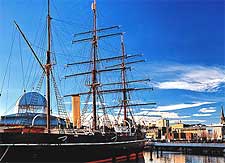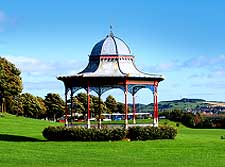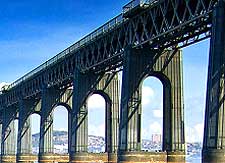Dundee History Facts and Timeline
(Dundee, Scotland, UK)

Dundee's history dates back all the way to prehistoric times. There's clear evidence of early occupation of the site, with discoveries of Pictish earthworks by archaeologists.
In those early years, the settlement would have been under the rule of a series of local chieftains. One such chieftain was thought to have been called Daig. It may be that the name Dundee means 'the hill or fort belonging to daig'. An alternative interpretation is that 'daig' may come from the Gaelic word meaning 'fire'.
The Middle Ages to Early Modern Times
The growth of Dundee is thought to relate to one event in its history in particular. At some point during the 12th century, Scottish King William the Lion granted Dundee a charter and gave the earldom to his brother. In the years that followed, the earldom was passed on to his ancestors. In 1292, it became a Royal Burgh.

Following the Battle of Dunbar in 1296 and the abdication of King John Balliol, Dundee was occupied by English forces. William Wallace, one of the leaders of the Scottish Wars of Independence, entered the fray when he stabbed the son of an English nobleman and was forced to flee. Wallace, who was educated in the city, started an uprising that ended with his capture and execution in 1305.
In the years that followed, the city continued to be a prime target for English invaders. In the mid-16th century, Dundee was once again occupied by English forces under Andrew Dudley. Then, a century later, it was besieged by Royalist soldiers under the Marquess of Montrose.
From the 16th century on, life in Dundee was dominated by the woollen and textiles industries. Large mills were built and the city became known as a major linen exporter. With its strong maritime heritage, it was also a centre for the whaling industry. In 1883, a humpback whale was reported to have floundered on the sandbanks of the Tay Estuary. The doomed animal was harpooned and put on public display.

Jute, Jam and Journalism
By the beginning of the 19th century, Dundee was home to over 30,000 people. Known now as a main producer of jute (a coarse fibre) rather than linen, the city saw extensive developments. The city's jute mills were the source of much of its wealth, leading to its establishment as a centre for financial investment. The Scottish Investment Trust was set up here in 1873 by Robert Fleming, one of the city's jute manufacturers. It invested in businesses all over the world, including American ranches, mining companies and railways. In fact, one of the largest cattle ranches in the USA was run from Dundee until as late as 1951. Much of the Texas oil industry was also financed from the city.
The city is also known as the pioneer of marmalade-making in Britain. The story goes that its discovery was purely an accident. During a storm, a ship carrying a cargo of oranges was forced into port at Dundee. The oranges were bought by a local grocer, whose wife transformed them into marmalade. The best-known local producer was James Keiller's and Sons.
Another of Dundee's famous creations are the comics named The Dandy and The Beano, first published in the 1930s. They continue to be produced by DC Thomson and Co, a major employer in the city from 1905 to the present day.
In the early years of 20th-century history, the city found itself beset by problems associated with the decline of some of its industries. In particular, the jute industry failed to compete with firms abroad. However, in more recent times, there's been something of a recovery, with the arrival of new businesses in the city. In 2001, regeneration started in earnest with the launch of a major plan to develop the Dundee Waterfront.
 Dundee's history dates back all the way to prehistoric times. There's clear evidence of early occupation of the site, with discoveries of Pictish earthworks by archaeologists.
Dundee's history dates back all the way to prehistoric times. There's clear evidence of early occupation of the site, with discoveries of Pictish earthworks by archaeologists. Following the Battle of Dunbar in 1296 and the abdication of King John Balliol, Dundee was occupied by English forces. William Wallace, one of the leaders of the Scottish Wars of Independence, entered the fray when he stabbed the son of an English nobleman and was forced to flee. Wallace, who was educated in the city, started an uprising that ended with his capture and execution in 1305.
Following the Battle of Dunbar in 1296 and the abdication of King John Balliol, Dundee was occupied by English forces. William Wallace, one of the leaders of the Scottish Wars of Independence, entered the fray when he stabbed the son of an English nobleman and was forced to flee. Wallace, who was educated in the city, started an uprising that ended with his capture and execution in 1305.